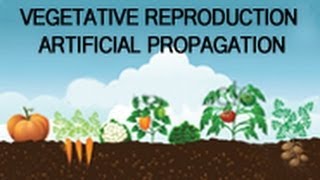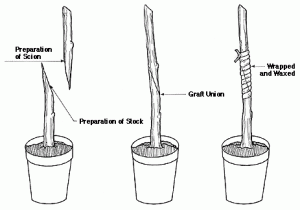
Vegetative propagation is a form of asexual reproduction occurring in plants in which a new plant grows from a fragment of the parent plant or grows from a specialized reproductive structure from the stem, root or leaf. Few important methods of artificial vegetative propagation in plants are as follows:
1.Cutting:
- Stem cutting: A piece of stem from the parent plant is partly buried in the soil, including at least one leaf node from where the new roots arise. For e.g rose, sugarcane etc.
- Root cutting: A section of root is buried just below the soil surface which will develop new shoots. For e.g lemon, fig, blackberry etc.
- Leaf cutting: A leaf consisting of buds is placed on moist soil which has to develop both new stems and new roots. A new plant develops at the base of the leaf. For e.g Begonia, Bryophyllum
2.Layering:
- The process of development of roots on a stem or branch while it is still attached to the parent plant is called layering.
- The rooted stem is then detached to become a new plant growing on its own roots and thus rooted stem is known as a layer.
- Layering is more complicated than cutting, but has the advantage that the propagated portion continues to receive water and nutrients from the parent plant while it is forming roots.
- Different types of layering are as follows:
a.Simple layering:
- A lower branch of a younger plant is bent to the ground so a node can be in contact with the soil.
- The node is wounded and covered with soil leaving the terminal end (6-12 inches) of the branch exposed.
- In a few weeks, roots will emerge from the buried portion after which the layer is separated from the mother plant and transplanted somewhere else. E.g. Guava, jasmine, rhododendron etc.

b.Compound (serpentine) layering:
- Compound layering is similar to simple layering, but instead of covering one wounded node with soil, 2 or 3 wounded nodes are covered with soil.
- The covered nodes alternate with uncovered, exposed nodes where new shoots can form above the ground.
- After roots develop, each segment can be cut along the branch forming multiple plants. E.g. guava, grapes, tomato etc.

c.Tip layering:
- It is similar to simple layering where a whole 3-4 inches deep is dug and the tip of a current season’s shoot is inserted and covered with soil.
- The tip grows downward first, then bends sharply and grows upward.
- Roots form at the bend and the re-curved tip becomes a new plant growing above the ground.
- The tip layer is removed and planted in late fall or early spring. E.g. purple and black raspberries, and trailing blackberries, strawberries etc.

d.Mound (stool) layering:
- Mound (stool) layering is useful in closely branched shrubs and rootstocks of tree fruits with heavy-stems.
- The plant is cut to 1 inch above the soil surface in the dormant season and the dormant buds will produce new shoots in the spring.
- A mound of soil rich in organic matter is placed over the new shoots as they grow around 8-10 cm tall and the roots will develop at the bases of these young shoots after few weeks.
- The layers are removed in the dormant season and transplanted to other places. E.g. apple rootstocks, , Magnolia, pear, plum etc.

e. Air layering:
- Air layering can be used to propagate large, overgrown house plants such as rubber plant that have lost most of their lower leaves and difficult to bend to the ground for the development of roots in soil.
- An area on a stem (about one foot from the tip) just below a node is chosen and leaves and twigs on the stem 3 to 4 inches above and below this point are removed.
- A 1-inch ring of bark is removed from the stem with a sharp knife leaving the inner woody tissue exposed.
- The newly bared ring is scraped to remove the cambial tissue to prevent a bridge of callus tissue from forming.
- The moist, unmilled sphagnum moss (about a handful) that has been soaked in water and squeezed to remove excess moisture is used to surround and cover the wound.
- The moss is wrapped with plastic and held in place with twist ties or electrician’s tape. Aluminum foil can also be used, as it does not require twist ties or tape to hold it in place. E.g. rubber plant, Dieffenchia etc.

3.Grafting:
- Grafting is a horticultural technique used to join parts from two or more plants so that they grow and develop as a single plant. In grafting, the upper part (scion) of one plant grows on the root system (rootstock) of another plant of closely related species.
- This method gives the plant a certain characteristic of the rootstock – for example, hardiness, drought tolerance, or disease resistance and certain property of the scion- for example, better quality of fruits.
- A healthy scion wood that is free from insect, disease, or winter damage is selected and the stock plants should be of good quality, healthy, and true to stock type.
- In grafting, the vascular cambium of the scion must be aligned with the vascular cambium of rootstock because of which a conductive tissue for the actively growing plant is developed in addition to stimulating tissue growth on the basal ends of many vegetative cuttings before they have rooted.
- Nurserymen and horticulturists use a number of different types of grafting methods in plants like mango, apple, pear, plum etc.as follows.
a. Slice grafting:
- Slice grafting is used to join a scion onto the stem of a root stock which is is usually applied to herbaceous materials that connect or join easily, or it is used on plants with a stem diameter of 1⁄2-inch or less(both the stock and scion having same diameter).
- The root stock is cut off using a diagonal cut 3⁄4-inch to 1 inch long with the same type of cut at the base of the scion.
- The scion is fit to the stock and wrapped securely with a rubber grafting strip or twine.
- The junction is properly sealed with grafting wax or grafting paint with regular watering of rootstock until the graft knits and the twine or strip is removed as soon as the graft has healed.

b.Whip and tongue grafting:
- This technique is most commonly used to graft nursery crops or woody ornamental in which equal sized scion and stock (no more than 1⁄2-inch in diameter) are taken
- The technique is similar to splice grafting except that the whip on the root stock holds the tongue of the scion in place (and vice versa) which leaves both hands free to wrap the joint.
- The stock is cut using a diagonal cut where the cut is four to five times longer than the diameter of the stock to be grafted and the same kind of cut is made at the base of the scion.
- A tongue like structure is made in the stock and scion respectively on that diagonal cut.
- The scion is fitted into the root stock so that they interlock whip and tongue with the proper alignment of their cambia.
- The junction is properly wrapped with a grafting strip or twine, and sealed with grafting wax or grafting paint.

c.Saddle grafting:
- Both root stock and scion should be of the same diameter with stock not being more than 1 inch in diameter.
- Using two opposing upward strokes of the grafting knife, the top was removed from the root stock which resulted in the inverted V shaped cut, with the surface of the cuts ranging from 1⁄2-inch to 1 inch long.
- The technique is reversed to prepare the base of the scion with cuts on the root stock and scion having the same length and the same slope so that maximum contact would be there between the stock and scion when they are joined.
- The V-notched scion is placed onto the saddle of the root stock and the graft is wrapped with a grafting twine, tape, or strip, and then sealed with grafting wax or grafting paint.

d.Cleft grafting:
- The rootstock (1-4 inches in diameter) is straight and bigger than the scion (1⁄4-inch in diameter). The scion should be straight, and long enough (6 and 8 inches) to have at least three buds.
- Using a clefting tool wedge, a split or “cleft” through the center of the stock is made and down 2 to 3 inches from the smooth horizontal stock surface.
- The cleft in the stock is held open to hold the scions together. One chisel shaped scion is inserted on each end of the cleft, with the wider side of the wedge facing outward making sure that the cambium of each scion is in contact with the cambium of the rootstock.
- The clefting tool is removed from the cleft so that the rootstock can close and hold the scions in place. All cut surfaces are properly sealed with grafting wax or grafting paint to keep out water and prevent drying.
